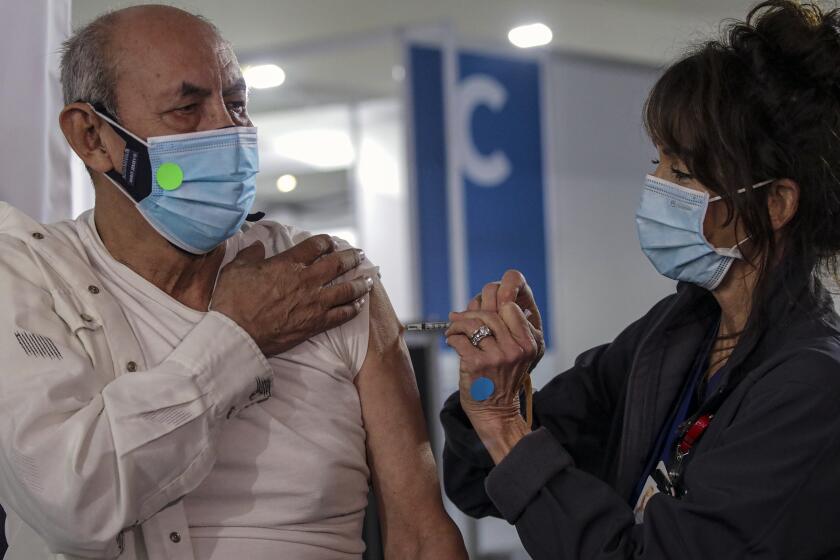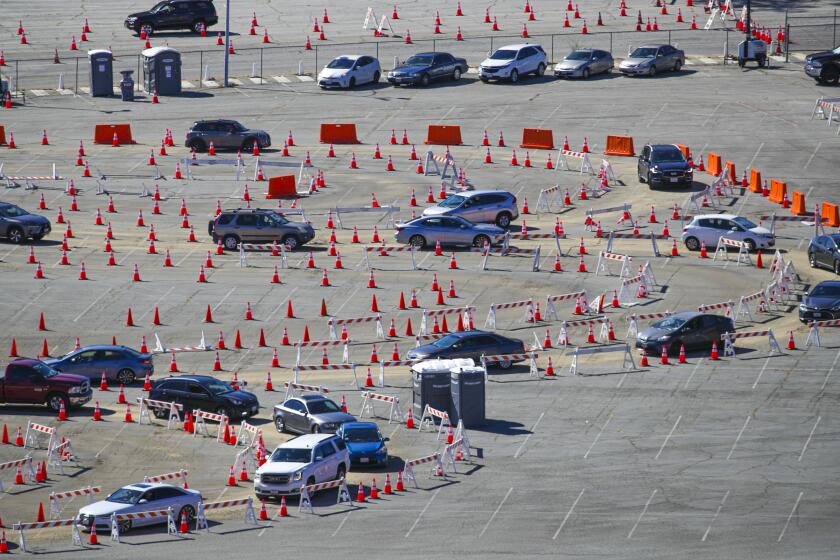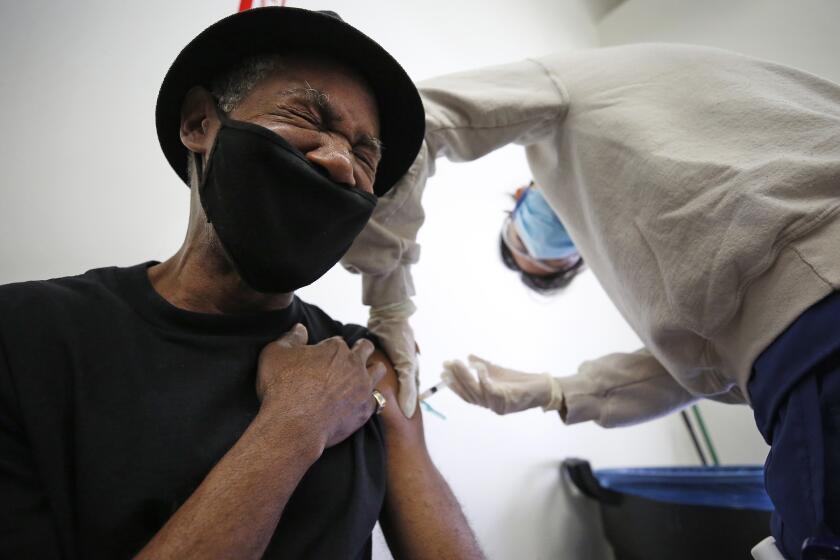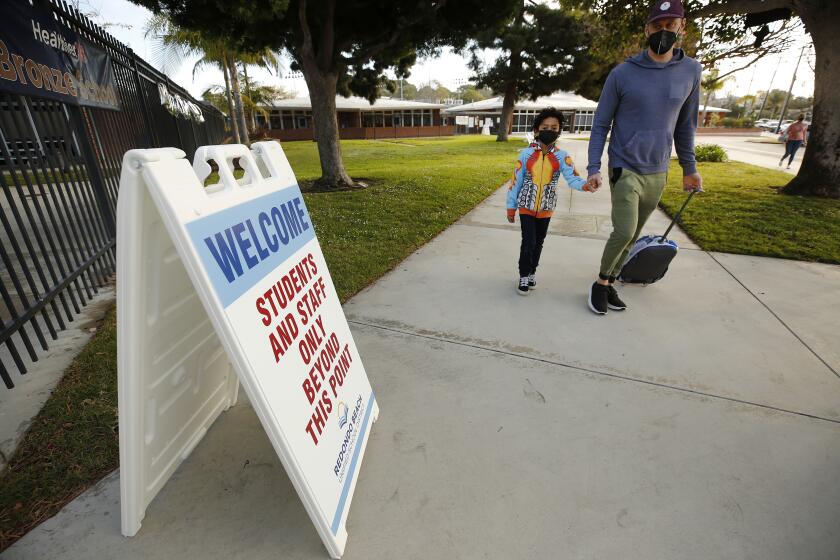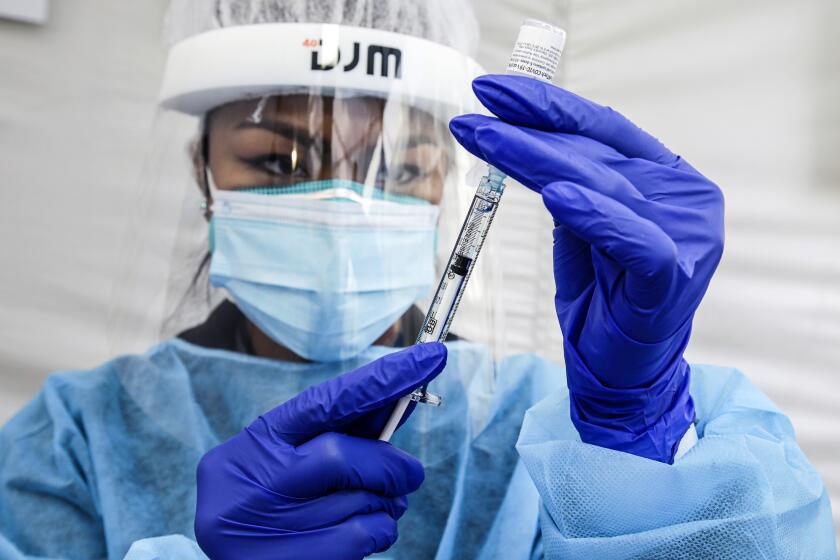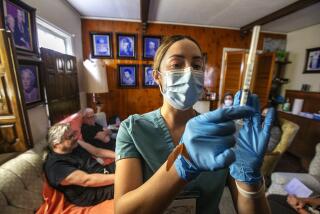California still facing acute shortages of COVID-19 vaccine as concerns about equity rise
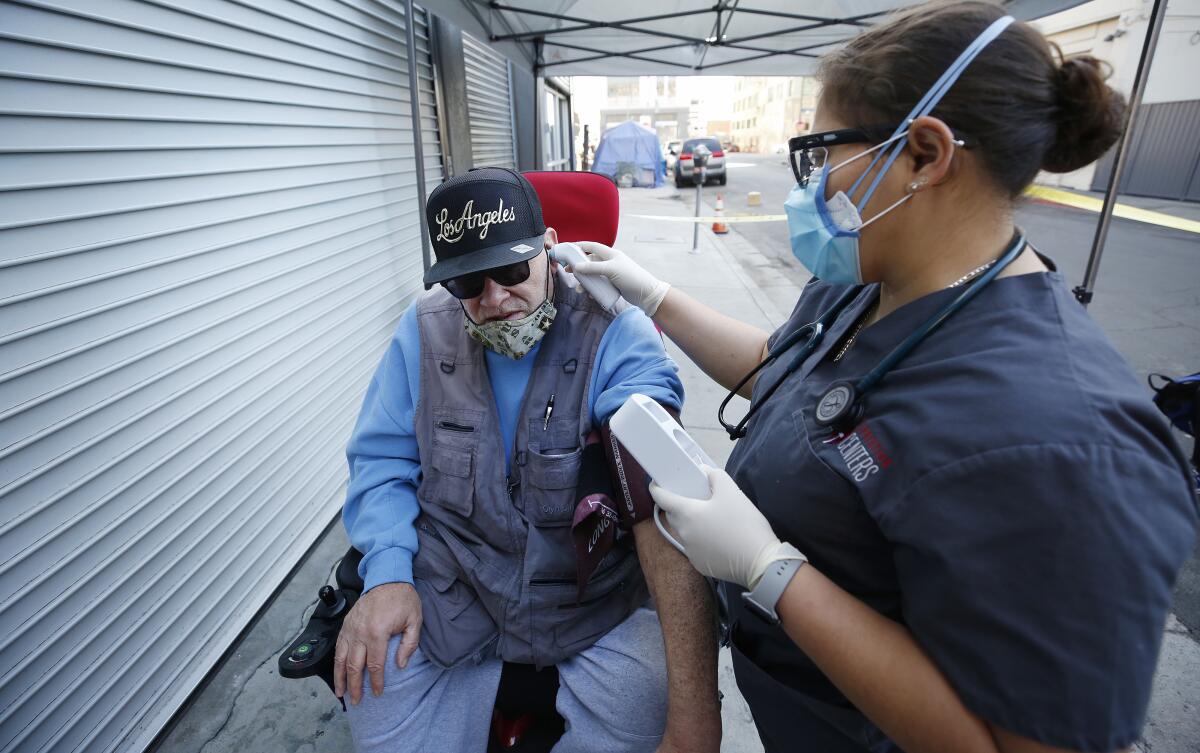
- Share via
Most of Los Angeles County’s supply of COVID-19 vaccine will be needed for second doses into next week, as even stepped-up shipments will be insufficient to break the bottleneck of people needing to complete their inoculation regimen, officials said.
County Public Health Director Barbara Ferrer said Monday that about 55% of the doses expected this week will be needed for second shots — which are required a few weeks after people initially roll up their sleeves.
County officials have already said they will be limited to administering second doses for the rest of the week starting Tuesday at a handful of their major vaccination sites: the Fairplex in Pomona, the Forum in Inglewood, the county Office of Education in Downey, Cal State Northridge, El Sereno, Six Flags Magic Mountain in Valencia and Balboa Sports Complex in Encino.
Although the county is committed to providing second doses as close to the recommended interval as possible — three weeks for Pfizer-BioNTech and four weeks for Moderna — Ferrer acknowledged that it was “hard to manage a vaccination program with so much variability in the weekly allocations.”
Most appointments offered at the major county-run vaccination sites will be needed for second doses, health officials say.
The nation’s most populous county has seen its vaccine shipments seesaw wildly over the past month, making it difficult for officials to accurately peg the supplies they’ll have to work with. About 193,950 doses arrived the week of Jan. 11, but 168,575 were delivered the following week and only 137,725 arrived the week after that.
Most recently, the county received 184,625 doses — a number expected to climb further this week, to more than 218,000.
“We’re encouraged that this week there’s an increase in our shipment, and we hope that this trend will continue,” Ferrer said during a briefing.
L.A. is far from alone in singing the vaccine blues. Officials throughout California have lamented the limited and variable vaccine shipments they’ve received, saying they have the capacity and capability to provide significantly more shots.
Wondering about how to get your second dose appointment? You’re not alone. L.A. County has updated its guidance again. Here’s what you need to know.
“Supply is the issue. That’s the constraint,” Gov. Gavin Newsom said Tuesday at a news conference announcing the opening of a new mass vaccination site at Levi’s Stadium in Santa Clara. “So when you ask me, ‘What are we doing to vaccinate this group, that group, what about this group, what about that group?’ It’s an issue now of scarcity. It’s an issue of supply.”
California, as a whole, received roughly 1.06 million vaccine doses last week, and Newsom said that number was expected to tick up only modestly this week.
Of last week’s allocation, 594,000 were for first doses, according to Newsom.
As long as the vaccine supply remains at current levels, there will not be enough doses to give people their second shots and also provide a significant number of newcomers their initial shots.
Slightly more than 3.8 million of California’s roughly 40 million residents have received at least one dose so far, according to data compiled by The Times. Significantly fewer people — just under 850,000 — have received both doses.
“The goal is pretty straightforward,” Newsom said. “The goal is to design a system that has only one limitation, and that’s supply, that has the capacity to deliver on our promotion and promise to vaccinate everybody in the state of California that chooses to be vaccinated. And I want to underscore that. The issue in this state, in this nation, is supply.”
The findings raised new concerns about inequity in the troubled rollout of vaccines for those 65 and older and add pressure on county leaders to do a better job of getting communities of color immunized.
State and local officials, however, have said that the need for speed must be balanced with ensuring vaccines are delivered equitably — and that California’s hardest-hit, harder-to-reach communities aren’t left behind.
Recent data released by L.A. County showed that Black, Latino and Native American seniors were receiving COVID-19 vaccinations at a lower rate than white, Asian American and Pacific Islander seniors in the county.
“We have a lot of work to do to fix this,” Ferrer said during Tuesday’s Board of Supervisors meeting, “because however way you cut this data, it’s clear that in some of our hardest-hit communities, there are populations that are not getting vaccinated at the same rate as other groups.”
Overall, only 7% of Black residents age 65 and over have received at least one dose of the COVID-19 vaccine, according to figures presented Monday. About 9% of Native American seniors and 14% of Latino seniors have received at least one dose — compared with 17% of white senior residents, 18% of Asian American and 29% of Native Hawaiian/Pacific Islander seniors.
“I think it’s important that we look at it as a two-prong issue. It’s supply, and it’s equitable distribution of that albeit very limited supply,” L.A. County Supervisor Holly Mitchell said Tuesday.
As of Monday, the county’s Department of Health Services, which serves thousands of low-income residents at its four public hospitals and about 30 clinics, had vaccinated 11,000 of its patients who were either at least 65 years old, healthcare workers or both.
Among those vaccinated by the county’s health services agency, 61% were Latino, 11% Asian, 9% Black, 3% white and 15% either multiracial, “other” race or unknown.
“We are currently conducting about 1,200 vaccinations per day, but the volume is entirely dependent on supply,” Dr. Christina Ghaly, the agency’s director, said during Tuesday’s Board of Supervisors meeting.
A large-scale vaccination site opened Tuesday at Levi’s Stadium in Santa Clara, with a goal of inoculating 15,000 people daily.
Newsom said he planned to release statewide demographic data on vaccine distribution later this week and foreshadowed it would “show what we all knew it was going to show, that we have a lot of work to do in terms of addressing those gaps and those disparities.”
“We have a unique responsibility and obligation to do more and do better,” he said.
Though the state is planning to collect and release vaccination data by race and ethnicity, much of that information is currently missing, and the collection process needs to improve, state epidemiologist Dr. Erica Pan said during a vaccine advisory committee meeting last week.
An emphasis is being placed on improving collection of demographic data as Blue Shield of California comes on board to administer the state’s vaccine program. Incentive payments will be made to local healthcare providers based on their ability to meet certain metrics, such as collecting real-time data and administering vaccines to the most vulnerable communities.
“We have to convince people that it’s OK to share it,” said Paul Markovich, Blue Shield of California’s president and chief executive, referring to people’s personal information. “That’s where I think we could use a lot of help — getting trust in the process.”
That information has been lacking throughout the country.
“We cannot ensure an equitable vaccination program without data to guide us,” said Dr. Marcella Nunez-Smith at a briefing last week.
“I’m worried about how behind we are,” she said. “We must address these insufficient data points as an urgent priority.”
Federal officials also announced a new strategy Tuesday to send doses directly to community health centers, “enabling them to vaccinate more of the people they serve,” said White House Press Secretary Jen Psaki.
“This announcement is another tool we are providing to state and local leaders in their work to reach underserved and hardest-hit populations,” she said during a briefing.
Officials in California have also said a key strategy in removing barriers to and allaying fears about vaccinations should involve tapping into already familiar and trusted resources in communities of need.
But that must be done with care. Mitchell, whose Second District includes a significant percentage of the county’s Black population, said it’s great for the county to open more vaccination sites in communities of color, but that many of them are frustrated because they have no control over who registers for their open appointments.
When residents hear of new vaccination sites opening in their communities, Mitchell said, the natural assumption is that they will be able to get their vaccines at those sites — but that hasn’t happened at the rate it should.
“That’s why our equity numbers are as paltry as they are,” Mitchell said.
Ferrer said she shares the frustration of federally qualified health centers, which predominantly serve low-income and uninsured residents and have to vaccinate whomever signs up.
“They end up seeing not their patients, not their neighbors, but people coming ... from 50 miles away because they managed to snag an appointment,” Ferrer said. “And that’s working against us.”
L.A. Supervisor Hilda Solis said the county must quickly get “boots on the ground” in hard-hit communities of color.
This should include using mobile units to offer door-to-door vaccinations, especially to those residents who don’t have vehicles or are homebound, Solis said.
“It’s not lost on me that African American and Latino communities are the ones that are really suffering the most,” said Solis, whose First District includes several predominantly Latino communities with high rates of coronavirus cases and deaths.
Solis added that she remains concerned about how quickly essential workers, particularly those who work in meatpacking, food service delivery and grocery stores can get vaccinated.
At the same time, though, the public must remain patient with the vaccine rollout and diligent in their efforts to protect themselves and their neighbors by continuing to wear face coverings, practicing social distancing and staying home as much as possible, Solis said.
With the school year rapidly slipping away, the issue of vaccines for teachers is at the center of negotiations between Gov. Gavin Newsom and lawmakers.
With the shortage, there has been considerable public discussion about whether officials should shift their focus to giving first doses to as many people as possible, rather than earmarking precious supplies to ensure on-time administration of a second dose.
The thinking goes that even one shot provides some level of protection against COVID-19. Officials have said if it’s not feasible to adhere to the recommended schedule, then in extremely rare circumstances administering the second dose within six weeks of the first dose may be done.
But federal officials are in agreement that the second dose should be delivered as close to the recommended timing as possible.
Dr. Anthony Fauci, the U.S. government’s top infectious-diseases expert, said Monday that the two-dose regimen unlocks the full benefits of the vaccine. Although the first dose provides “some degree of protection,” the second dose multiplies the level of protection by a factor of 10.
That’s important not only “because of the height of the response and the potency of the response, but as you get to that level of antibody you get a greater breadth of response,” he said during a White House COVID-19 Response Team briefing. “And by breadth of response, we mean it covers not only the ... currently circulating virus, but also the variants that we see circulating.”
Officials predict the B.1.1.7 variant, first identified in the U.K., will become the dominant coronavirus strain nationwide by the end of March.
Delaying the second dose for too long on a widespread scale, he said, could invite the spread of more problematic viral mutants — including the more infectious strain first identified in Britain, which has now been found in a handful of California counties, including L.A., Orange, San Diego, San Bernardino, Alameda, San Mateo and Yolo.
“We feel the optimum approach,” Fauci said, “would be to continue with getting as many people on their first dose as possible, but also making sure that people, on time, get their second dose.”
Officials have said they expect vaccine shortages to ease in the coming months, with the arrival of additional Pfizer and Moderna shipments and the likely introduction of a third vaccine manufactured by Johnson & Johnson, which requires only a single dose.
At any rate, additional study would be needed to figure out the full ramifications of a delayed-dose approach, and Fauci said doing so “would take several months to get a meaningful answer.”
“At that time,” he said, “the amount of vaccine that would be available would almost be making that question somewhat of a moot point.”
More to Read
Sign up for Essential California
The most important California stories and recommendations in your inbox every morning.
You may occasionally receive promotional content from the Los Angeles Times.
